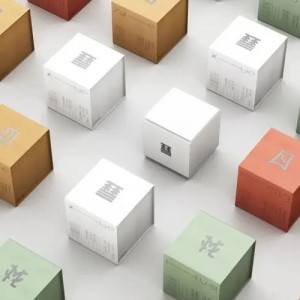As consumer standards rise, businesses are increasingly focusing on product packaging that is safe, environmentally friendly, and well-designed. Among the various types of packaging, do you know which materials are most commonly used?
一. Paper Packaging Materials
Throughout the development of packaging design, paper has been widely used as a common material in both production and everyday life. Paper is cost-effective, suitable for mass mechanical production, easy to shape and fold, and ideal for fine printing. Additionally, it is recyclable, economical, and environmentally friendly.
1. Kraft Paper
Kraft paper has high tensile strength, tear resistance, burst resistance, and dynamic strength. It is tough, affordable, and has good fold resistance and water resistance. It is available in rolls and sheets, with variations such as single-sided gloss, double-sided gloss, striped, and unpatterned. Colors include white and yellowish-brown. Kraft paper is mainly used for packaging paper, envelopes, shopping bags, cement bags, and food packaging.
2. Coated Paper
Also known as art paper, coated paper is made from high-quality wood or cotton fibers. It has a coated surface to increase smoothness and gloss, available in single-sided and double-sided versions, with glossy and textured surfaces. It has a smooth surface, high whiteness, excellent ink absorption and retention, and minimal shrinkage. Types include single-coated, double-coated, and matte-coated (matt art paper, more expensive than standard coated paper). Common weights range from 80g to 250g, suitable for color printing, such as high-end brochures, calendars, and book illustrations. Printed colors are bright and rich in detail.
3. White Board Paper
White board paper has a smooth, white front and a gray back, primarily used for single-sided color printing to make paper boxes for packaging. It is sturdy, with good rigidity, surface strength, fold resistance, and print adaptability, making it suitable for packaging boxes, backing boards, and handmade items.
4. Corrugated Paper
Corrugated paper is light yet strong, with excellent load-bearing and compression resistance, shockproof, and moisture-proof properties, and is cost-effective. Single-sided corrugated paper is used as a protective layer or for making light partitions and pads to protect products during storage and transport. Three-layer or five-layer corrugated paper is used for product packaging, while seven-layer or eleven-layer corrugated paper is used for packaging machinery, furniture, motorcycles, and large appliances. Corrugated paper is categorized by flute types: A, B, C, D, E, F, and G flutes. A, B, and C flutes are generally used for outer packaging, while D and E flutes are used for smaller packaging.
5. Gold and Silver Card Paper
To enhance the quality of printed packaging, many customers choose gold and silver card paper. Gold and silver card paper is a specialty paper with variations such as bright gold, matte gold, bright silver, and matte silver. It is made by laminating a layer of gold or silver foil onto single-coated paper or gray board. This material does not easily absorb ink, requiring quick-drying ink for printing.
Therefore, packaging materials need to have good performance to protect and promote products and be cost-effective. Common plastics such as polyethylene (PE) and polypropylene (PP) are preferred for their excellent properties, large production volumes, and low cost.
Plastics are water-resistant, moisture-resistant, oil-resistant, and insulating. They are lightweight, can be colored, easily produced, and can be molded into various shapes to suit printing needs. With abundant raw material sources, low cost, and excellent performance, plastics are one of the most important materials in modern sales packaging.
Common plastic packaging materials include polyethylene (PE), polypropylene (PP), polyvinyl chloride (PVC), and polyethylene terephthalate (PET).
Post time: Jun-17-2024












